
By Degree(s): Measuring Employer Demand for AI Skills by Educational Requirements
Sergio Galeano, Nyerere Hodge, and Alexander Ruder
May 21, 2025
https://doi.org/10.29338/wc2025-01
Download the full text of this paper (1,538 KB)
The rapid advancement of artificial intelligence (AI) has prompted widespread interest and discussion about its potential to transform the labor market. For workforce development practitioners, a key issue is how AI is changing the nature of work, mainly through changes in the skills workers need to be competitive for the jobs of today and of the future.
In this Workforce Currents, we explore the growth of employer demand for AI skills in online job postings data between 2010 and 2024. Lightcast, a labor analytics firm, provides job postings data that includes several useful features of each posting, such as the skills required to perform the job functions, the education level required, and the occupation title.1 While other researchers have documented the overall and industry- or occupation-specific growth in AI skill demand,2 we investigate how AI skill demand has changed for occupations with differing levels of required education. We ask whether the growth in AI skill demand is concentrated in occupations that require a bachelor's degree or higher, or whether AI skill demand is growing even in occupations that require an associate degree or high school diploma. The answer to these questions can inform workers as they choose training programs and help workforce development practitioners align certificate and associate degree curricula to meet the changing needs of employers.
Key Takeaways
- In 2024, nearly 628,000 job postings demanded at least one AI skill.
- The percentage of all job postings that require at least one AI skill increased from about 0.5 percent in 2010 to 1.7 percent in 2024.
- The demand for AI skills varies by education: job postings that require at least a bachelor's degree are more likely to require an AI skill than postings that require an associate degree or high school diploma.
- AI skill demand is increasing for occupations that require at least an associate degree, growing from 0.4 percent in 2010 to 1.4 percent in 2024. This demand growth is mostly concentrated in Computer and Mathematical occupations.
Background
Employers may be increasing demand for AI skills because either a greater share of overall employment is engaged in the technical roles of producing AI, or more workers are using AI in their jobs. Evidence suggests AI skill demand growth is occurring through both channels. First, more workers are employed in STEM occupations. From 2010 through 2024, STEM employment as a share of all jobs increased by more than 50 percent, from 6.5 percent to nearly 10 percent of all jobs.3 The Bureau of Labor Statistics projects the fastest 2023-2033 employment growth to be in the Professional, Scientific, and Technical Services industry sector, in which Computer Systems Design and Related Services is the fastest-growing subsector and Data Scientists is the fastest-growing occupation.4 Second, more workers may be using AI in their jobs. The growing use of generative AI (GenAI) on the job is documented in a 2024 national survey of working-age US adults, in which researchers found that nearly 27 percent of workers had used GenAI at work.5
We may expect to find differences in AI skill demand across educational requirements for at least two reasons. First, although the majority of the STEM workforce does not hold a bachelor's degree (52 percent of STEM workers do not hold a bachelor's degree), STEM workers with a bachelor's degree or higher are far more likely to be in science and engineering occupations than workers without a bachelor's degree (90 percent versus 26 percent respectively).6 Second, recent advances in AI, particularly GenAI, are projected to have the largest impact on professional, white-collar occupations that require advanced educational degrees.7 These trends each point to greater AI demand in jobs that require a bachelor's degree or more.
The extent to which AI skill demand is increasing in occupations that require less than a bachelor's degree is less clear. However, several trends suggest we should find an increase in the share of postings that demand AI skills in occupations that require less than a bachelor's degree. The percentage of the STEM workforce without a bachelor's degree increased from 19 percent to 21 percent (corresponding to 1.4 million workers) between 2011 and 2021; moreover, the percentage of workers without a bachelor's degree in science and engineering occupations increased by 44 percent, from 1.6 percent in 2011 to 2.3 percent in 2021.8 The demand for AI skills is also increasing across a broad range of occupations outside of technology, including technical writing, marketing, and management analysts.9 Finally, organizations are using GenAI for more functions, such as marketing and sales, service operations, and human resources.10
AI's Effect on Employer Skill Demand
AI and GenAI are already changing the set of skills employers are demanding from the workforce. A 2024 Federal Reserve Bank of Atlanta Macroblog post showed that the percentage of job postings requiring AI-related skills has increased steadily between 2010 and 2019.11 The pace of growth accelerated through the first eight months of 2024, with the percentage of all online job postings that require an AI skill reaching 1.62 percent. The researchers also find that demand for AI skills is rising not just in computer and mathematical occupations but in a broader set of occupations, which they attribute to the increasing technical capabilities of AI to perform more tasks.12
Figure 1 tracks AI skill demand from 2010 through the end of 2024. The figure shows the percentage of online job postings requiring at least one AI skill. In 2010, job postings that require AI skills represented about 0.5 percent of online job postings. The percentage steadily increases to 2023. While the percentage dips in 2023,13 there is a sharp rebound of 0.4 percentage points (or a 31 percent change) from 2023 to 2024, which coincides with a significant increase in adoption of AI tools and GenAI in particular.14 In 2024, demand for AI skills increased to 1.7 percent, or a 240 percent increase from the 2010 level in the percentage of postings requiring AI skills.
Figure 1: Online Job Postings Requiring AI Skills
Annual, Percent
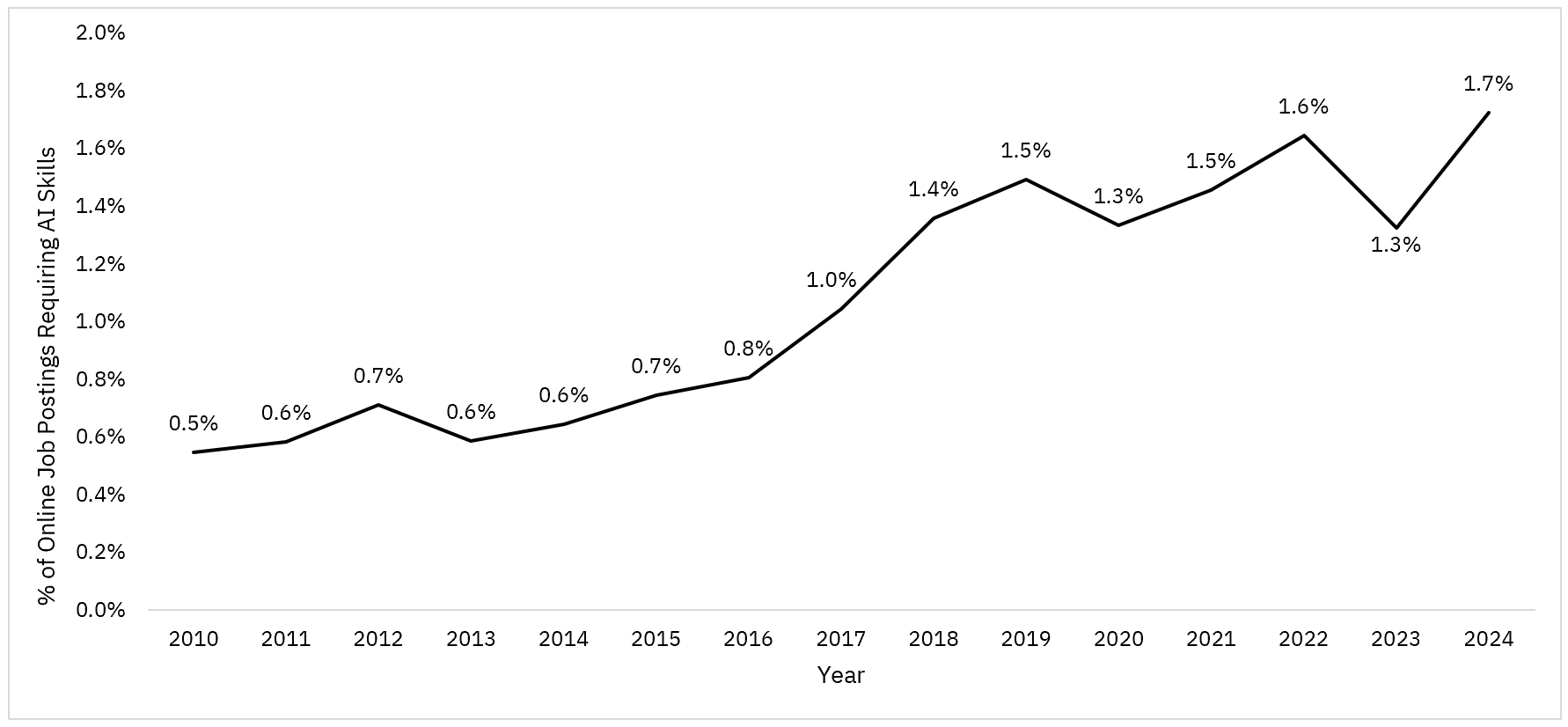
Source: Authors' calculations of Lightcast data. The percent labels on the line have been rounded to the nearest tenth.
The growth of AI skill demand has varied across occupations. Figure 2 shows AI skill demand as a percentage of all postings within major occupational groups in the Standard Occupational Classification (SOC) system. We find the highest demand for AI skills in Computer and Mathematical occupations. AI skill demand in this occupation group has grown from 1.6 percent of postings in 2010 to 12.3 percent of postings in 2024. All other SOC occupation groups have shares of 3.2 percent or less in 2024. Only four occupational groups (Architecture and Engineering; Business and Financial Operations; Management; and Life, Physical, and Social Science) have percentages greater than 2.0 percent.
Figure 2: Online Job Postings Requiring AI Skills by Occupation Group
Annual, Percent
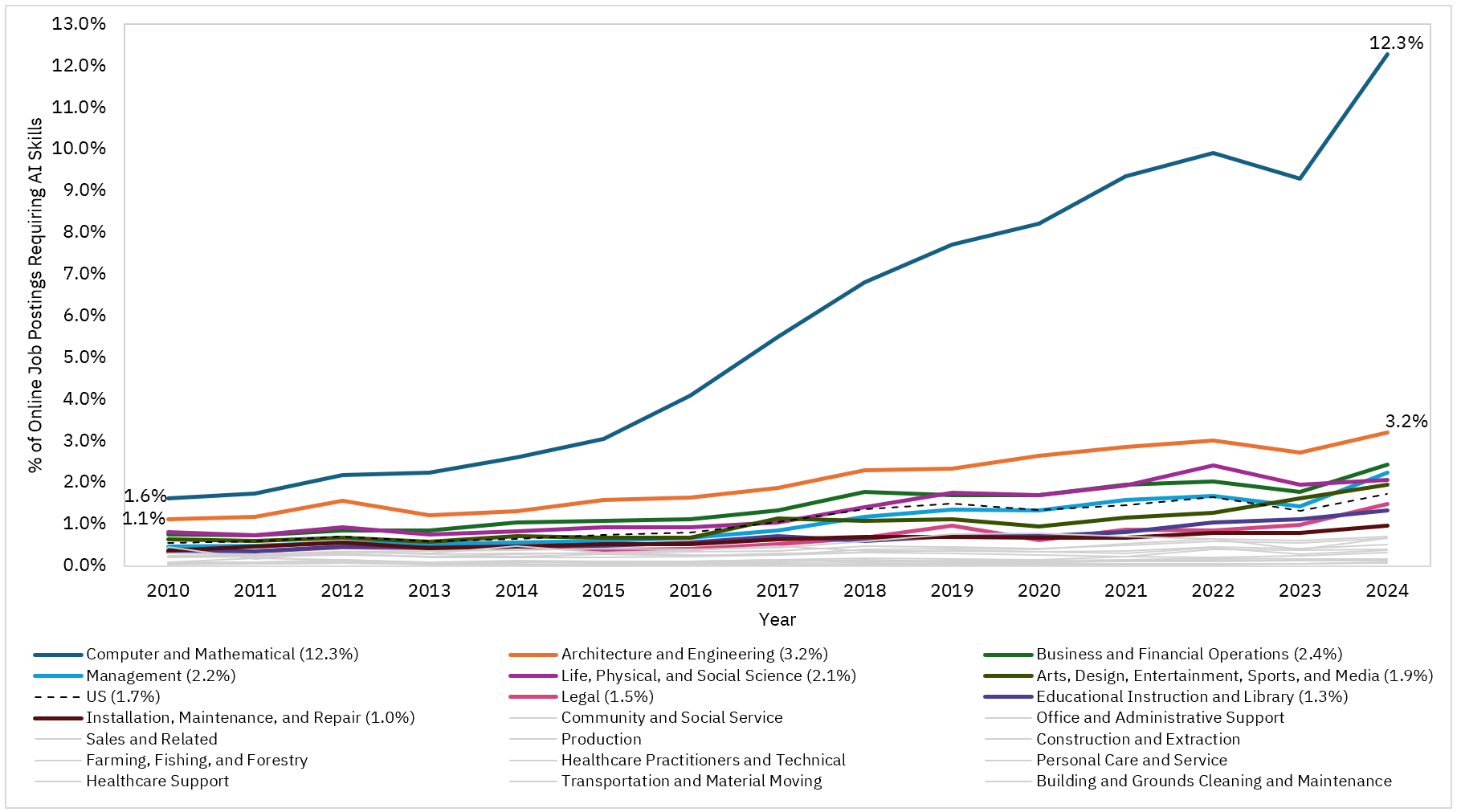
Source: Authors' calculations of Lightcast data. Figures in parentheses reflect percent of online job ads requiring AI skills in 2024. Chart is limited to occupation groups where demand for AI skills was 1 percent or higher in 2024. All other occupation groups had demand that was less than 1 percent in 2024, including: Community and Social Service; Sales and Related; Office and Administrative Support; Production; Construction and Extraction; Farming, Fishing, and Forestry; Healthcare Practitioners and Technical; Personal Care and Service; Healthcare Support; Transportation and Material Moving; Building and Grounds Cleaning and Maintenance; Food Preparation and Serving Related.
Is AI Skill Demand Increasing for all Education Levels?
Figure 2 showed that the greatest demand for AI skills is concentrated in Computer and Mathematical occupations. The next question is whether this demand growth is concentrated in occupations that require at least a bachelor's degree (BA+). A greater demand growth in BA+ roles would be expected for at least several reasons. We previously noted that workers in science and engineering fields are more likely to have a bachelor's degree than not. The National Center for Science and Engineering Statistics also projects science and engineering occupations to have greater expected job growth than all other occupation groups.15 Furthermore, an analysis of 2017—2023 job postings compared AI skill demand between private and public sector employers, finding that both types of employers are more likely to require a bachelor's degree than an associate degree for AI occupations.16
Figure 3 shows the percentage of online job postings requiring at least one AI skill by the minimum education requirement listed in the posting: high school diploma or the General Educational Development (GED) certificate, associate degree, bachelor's degree, master's degree, and PhD or professional degree. As expected, the greatest demand for AI skills is in occupations that require at least a bachelor's degree. The percentage of postings in 2024 that require an AI skill is 5.3 percent for a PhD or professional degree, 5.0 percent for a master's degree, and 4.7 percent for a bachelor's degree; moreover, these percentages have grown considerably since 2010. Percentages are lower for occupations that require at least an associate degree (1.4 percent) and occupations that require a high school diploma or GED (0.5 percent).
Figure 3: Online Job Postings Requiring AI Skills by Minimum Education Requirement
Annual, Percent
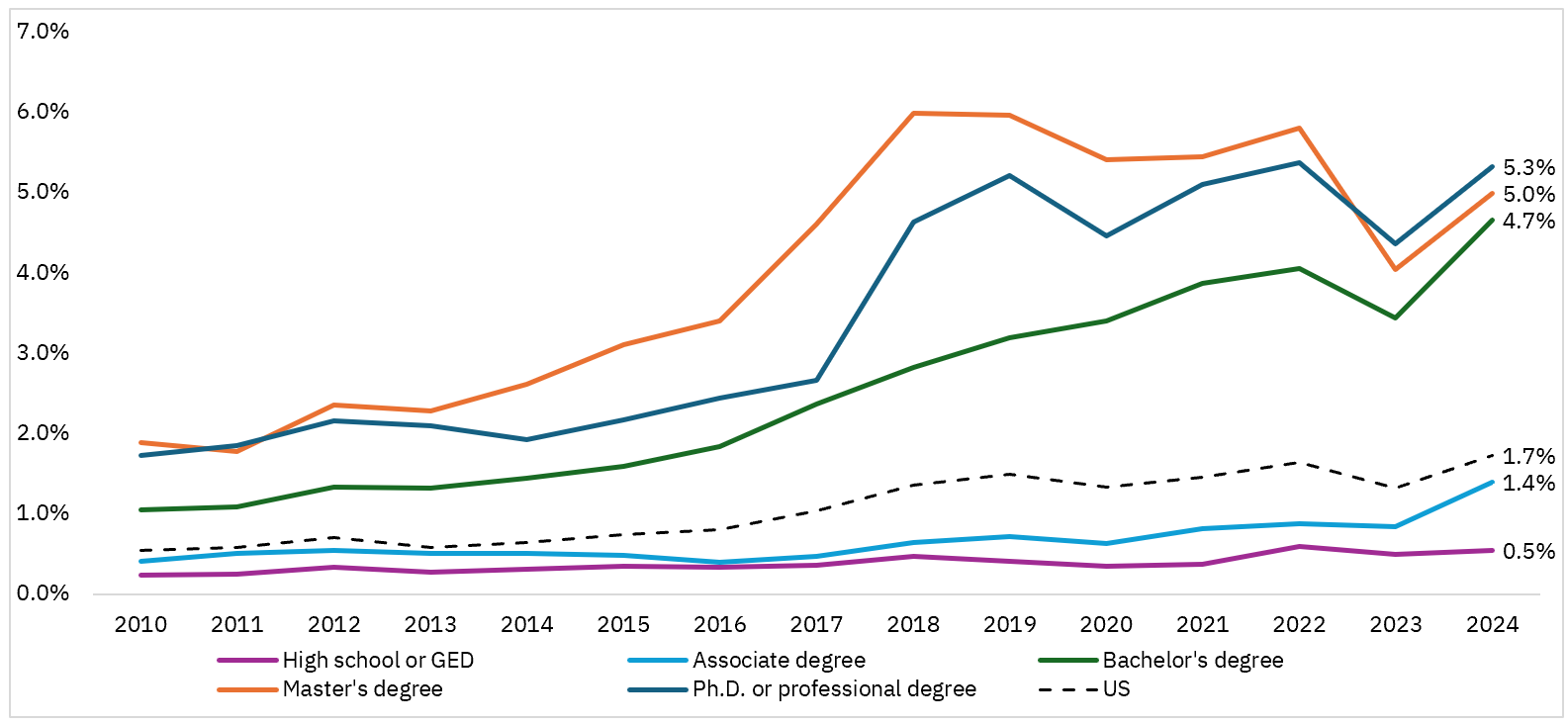
Source: Authors' calculations of Lightcast data.
We have suggested at least three reasons why AI demand may be increasing in occupations that require a high school diploma or associate degree (HS/AA): the growth in the STEM workforce that does not have a bachelor's degree, the demand for AI skills increasing across broad occupational groups, and increasingly broad organizational adoption of GenAI. Figure 3 shows that AI skill demand increased for occupations that require an associate degree and those that require a high school diploma or GED. The increase was greater for the associate degree category, in which the percentage grew from 0.4 percent in 2010 to 0.8 percent in 2023. It increased an additional 0.6 percentage points in 2024 to 1.4 percent.
To understand the drivers of this growth, we now explore the occupation groups in which this demand growth is occurring to discern if it is happening across diverse occupation groups, or if it is concentrated within Computer and Mathematical occupations. Figure 4 plots the major SOC occupation groups by the percentage of 2024 job postings that require an AI skill (y-axis) and the 2010–2024 annualized growth rate in postings with an AI skill (x-axis). The chart is divided into four quadrants based on the value of these statistics calculated on the full sample of job postings. The upper right quadrant, for example, represents occupation groups in which the percentage of job postings that require an AI skill is above the US percentage for all job postings that require an AI skill (1.7 percent); job postings for these occupational groups are also growing at an annualized rate that is above the AI postings growth rate for all jobs in the US (8.6 percent). This quadrant is high growth, high demand. The other three quadrants are similarly defined as high growth, low demand; low growth, high demand; and low growth, low demand.
Figure 4: Annualized Growth and 2024 Online Job Postings for AI Skills by Occupation Group and Minimum Education Requirement
2010–2024, Percent
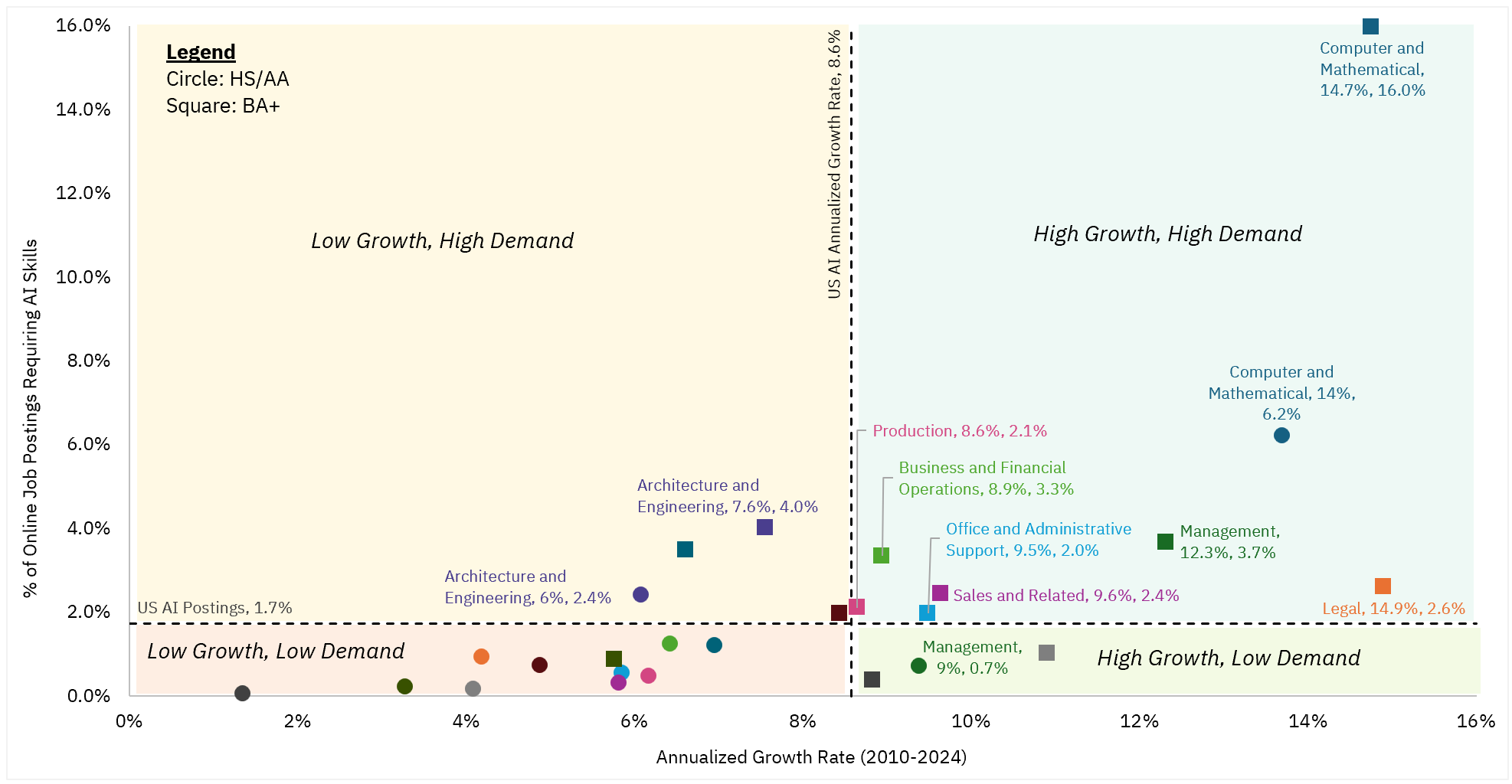

Source: Authors' calculations of Lightcast data. Each point represents a major (two-digit) SOC occupational group. The horizontal axis represents the annualized growth rate of postings that include at least one AI skill. The vertical axis represents the 2024 percentage of online job ads that include at least one AI skill. The dashed horizontal line reflects overall US demand for AI skills in job postings in 2024 (1.7 percent). The dashed vertical line represents the annualized growth rate of the share of US job postings with AI skills from 2010 to 2024 (8.6 percent). Labels within the figure are only provided for high-growth, high-demand occupational groups and those mentioned in the text.
Growth in AI skill demand for HS/AA occupations is heavily concentrated in Computer and Mathematical occupations. The Computer and Mathematical category is the only occupation group in the upper right quadrant for HS/AA occupations, showing a 14 percent annualized growth rate and 6.2 percent of job postings in 2024 requiring AI skills. The Management category for HS/AA occupations is in the lower right quadrant, with high AI demand growth (9 percent) but low 2024 AI skill demand (0.7 percent). The Architecture and Engineering category for HS/AA occupations is in the top left quadrant, signifying slower growth of AI skills (6 percent) but demand for AI skills (2.4 percent) that is higher than the US level in 2024. All other occupation groups for HS/AA roles are in the low AI growth, low 2024 AI skill demand quadrant. In contrast, for job postings that require a BA+, seven occupational groups are in the high growth, high 2024 AI skill demand quadrant (upper right), and only one is in the low growth, low 2024 AI skill demand quadrant (lower left). Together, these results suggest that growth in AI skill demand for associate degree occupations is primarily driven by high growth and high demand for AI skills in Computer and Mathematical and Management occupations. While AI skill demand growth in the BA+ category is also heavily concentrated in the Computer and Mathematical occupations, the demand growth is more spread across occupation groups than for HS/AA occupations.
The most in-demand AI skills may differ between HS/AA and BA+ occupations since AI demand is high and growing across more occupation groups in the BA+ group than in the HS/AA group. However, we find that the AI skills in demand are notably similar for occupations in the HS/AA and BA+ groups. Tables 1a and 1b show the top ten in-demand AI skills for postings in the HS/AA group (table 1a) and the BA+ group (table 1b). Six of the top ten skills in table 1a are also in table 1b.17
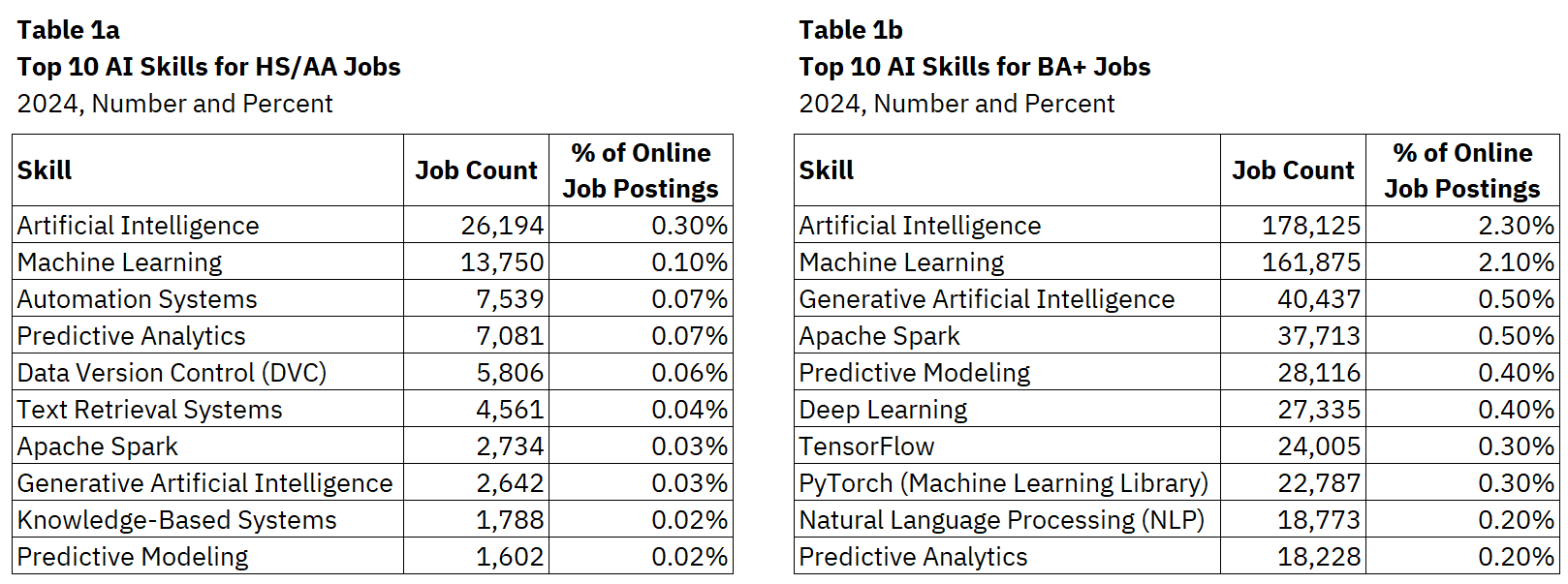
Source: Authors' calculations of Lightcast data. The third column in table 1a shows the percent of all HS/AA postings that require that skill. The third column in table 1b shows the percent of all BA+ postings that require that skill.
Conclusion
AI skill demand is rising quickly for Computer and Mathematical occupations no matter the required level of education for the jobs. Given the STEM employment trends discussed in the Background section, the rise of AI skill demand for BA+ jobs is unsurprising. However, the data show that the AI boom is affecting occupations even at the HS/AA level. Workers trained at two-year and technical colleges are competing for occupations in which knowledge of AI skills is expected.
Of course, workers with an HS/AA degree may not be competing for the same roles as workers with a BA+ degree. Makridis and Alterovitz, for example, analyzed the demand for AI skills in 2017–2023 job postings between public and private sector employers.18 They found that public sector employers are more likely to hire at the HS/AA level than private sector employers, in both technical and non-technical AI occupations. In supplementary analysis of the 2024 job postings data, we find a similar result. Nearly 19 percent of public sector AI jobs are posted at the HS/AA level compared to only 9 percent of private sector AI jobs.19
The data show a significant difference in the concentration of growth across occupation groups based on educational level. Only one occupation group in the HS/AA group has high AI growth and high 2024 demand for AI skills. In the BA+ group, seven occupational groups have high AI growth and high 2024 demand for AI skills. BA+ workers with AI skills are in demand in a broader range of occupations than HS/AA workers. Future analysis could explore explanations for this difference, asking why BA+ workers with AI skills are seemingly able to work in more occupation groups than workers with a HS/AA degree only.
We also find notable similarities in the specific AI skills that employers demand between HS/AA occupations and BA+ occupations. Once again, future analysis could build on this finding by comparing AI-related jobs for BA+ and HS/AA occupations. This research could explore such questions as: Do BA+ occupations require a broader set of skills than HS/AA occupations or not? And, do BA+ occupations require more depth of knowledge and experience than HS/AA occupations or not? The answers could inform workers and education providers seeking to align skills to the labor market.
Appendix: Methodology
We use online job postings data from Lightcast (formerly Burning Glass) to analyze AI skill demand. Lightcast includes the near universe of online job postings posted each day throughout the country. Each posting contains information such as employer, job title, industry, skills, education requirements, and more. Our analysis included 427.6 million online job postings from 2010 through 2024. The longitudinal, high-frequency, detailed information for job postings allows us to document growth and changes in the demand for AI skills.
The Lightcast skills taxonomy, which is open to the public via its Lightcast Open Skills Library,20 includes more than 32,000 unique skills. Lightcast defines a skill as "competencies at specific tasks or familiarity with specific subjects and tools acquired through education or experience."21 We identified 349 unique skills related to AI for this analysis. The taxonomy groups skills into several categories, including "Artificial Intelligence and Machine Learning (AI/ML)" and "Natural Language Processing (NLP)." Our analysis included all the skills from these two categories, which account for 294 skills or 84 percent of the skills used in this analysis. The remaining 55 skills were manually identified by reviewing STEM-related skill categories, using keyword searches for terms like artificial intelligence, AI, machine learning, ML, and generative, and additional independent research to validate that the additional skills were AI. For example, we include Apache Spark, which is a processing engine often used to develop machine learning tasks, and pattern recognition, which is an application of machine learning that identifies trends in big data. Other AI skills include artificial intelligence, machine learning, computer vision, decision tree learning, deep learning, face detection, speech recognition, and more.
Our skills-based approach to defining and identifying AI jobs is an expansion on methods used by Paul Mohnen and David Lee (2024).22 Mohnen and Lee also utilized the Lightcast data, similarly, leveraging its Artificial Intelligence and Machine Learning (AI/ML) category. Our approach added the Natural Language Processing (NLP) category of skills, a manual review of the STEM skill categories, and keyword searches against the broader taxonomy.
Please send comments to the corresponding author at Sergio.Galeano@atl.frb.org.
The Federal Reserve Bank of Atlanta's Community and Economic Development function supports the Central Bank's mandate of stable prices and maximum employment by helping improve the economic opportunity of low- and moderate-income (LMI) individuals and underserved places for a stronger economy for all Americans. Community development is one of the Federal Reserve's core functions and this responsibility is rooted in its mandates from Congress. Our Workforce Currents series addresses emerging and critical issues in workforce development. Find more research, use data tools, and sign up for email updates at atlantafed.org/commdev. The views expressed here are the authors' and not necessarily those of the Federal Reserve Bank of Atlanta or the Federal Reserve System. Any remaining errors are the authors' responsibility.
1 See the Appendix: Methodology for more details about Lightcast.
2 Liudmila Alekseeva et al., "The Demand for AI Skills in the Labor Market," Labour Economics 71 (2021): 102002, https://doi.org/10.1016/j.labeco.2021.102002; Paul Mohnen and David Lee, "Recent Trends in the Demand for AI Skills" (Federal Reserve Bank of Atlanta Macroblog, October 15, 2024), www.atlantafed.org/blogs/macroblog/2024/10/15/recent-trends-in-demand-for-ai-skills.
3 David Deming, Christopher Ong, and Lawrence H. Summers, "Technological Disruption in the US Labor Market," in Strengthening America's Economic Dynamism, ed. Melissa S. Kearney and Luke Pardue (Aspen Economic Strategy Group, 2024), www.economicstrategygroup.org/publication/strengthening-americas-economic-dynamism/.
4 Elka Torpey, "The Fastest Growing Industry Sector, 2023–2033: Professional, Scientific, and Technical Services" (United States Bureau of Labor Statistics Career Outlook, 2025), www.bls.gov/careeroutlook/2025/article/fastest-growing-industry-sector.htm.
5 Alexander Bick, Adam Blandin, and David J. Deming, "The Rapid Adoption of Generative AI" (NBER Working Paper 32966, Revised February 2025), www.nber.org/system/files/working_papers/w32966/w32966.pdf.
6 National Science Board, National Science Foundation, "The STEM Labor Force: Scientists, Engineers, and Technical Workers" (Science and Engineering Indicators 2024, NSB-2024-5, Alexandria, VA., 2024), https://ncses.nsf.gov/pubs/nsb20245/.
7 Michael Chui et al., "The Economic Potential of Generative AI: The Next Productivity Frontier" (McKinsey & Company, June 14, 2023), www.mckinsey.com/capabilities/mckinsey-digital/our-insights/the-economic-potential-of-generative-ai-the-next-productivity-frontier; Gad Levanon, "Generative Artificial Intelligence and the Workforce" (Burning Glass Institute and the Society for Human Resource Management, February, 2024), www.burningglassinstitute.org/research/generative-artificial-intelligence-and-the-workforce.
8 National Science Board, National Science Foundation, "The STEM Labor Force: Scientists, Engineers, and Technical Workers."
9 Mohnen and Lee, "Recent Trends in the Demand for AI Skills."
10 Alex Singla et al., "The State of AI in Early 2024: GenAI Adoption Spikes and Starts to Generate Value" (QuantumBlack AI by McKinsey, May 30, 2024), www.mckinsey.com/capabilities/quantumblack/our-insights/the-state-of-ai-2024.
11 Mohnen and Lee, "Recent Trends in the Demand for AI Skills."
12 Alekseeva et al. benchmark the growth of AI skill demand to growth in the demand for both general computer and specialized software skills. They find that the share of job postings requiring general computer skills is nearly flat between 2010 and 2019, while that of specialized software skills declined slightly.
13 Lightcast speculates that the 2023 dip is driven by major technology employers both reducing their total job postings and shifting the composition of postings away from technology to service and operations roles. See page 223 in Nestor Maslej et al., "The AI Index 2024 Annual Report," AI Index Steering Committee, Institute for Human-Centered AI, Stanford University, Stanford, CA, April 2024.
14 Singla et al., "The State of AI in Early 2024: GenAI Adoption Spikes and Starts to Generate Value."
15 National Science Board, National Science Foundation, "The STEM Labor Force: Scientists, Engineers, and Technical Workers." See figure LBR-A.
16 Christos A. Makridis and Gil Alterovitz, "Measuring and Understanding Differences in Private and Public Sector Technology Jobs" (Working Paper, last revised July 10, 2024), Available at SSRN: https://papers.ssrn.com/sol3/papers.cfm?abstract_id=4891300.
17 The exceptions for the high school diploma/associate's degree group are Data Version Control (DVC), Knowledge-based systems, and OpenAI Gym Environments. For the BA+ group, the exceptions are Tensor Flow, PyTorch, and Natural Language Processing.
18 Makridis and Alterovitz, "Measuring and Understanding Differences in Private and Public Sector Technology Jobs."
19 We also find that nearly 25 percent of AI job postings in both the public and private sector do not list education requirements. Makridis and Alterovitz (cited above) suggest this may be due to employers reconsidering degree requirements that pose an unnecessary burden to hiring AI talent.
20 Lightcast, "Open Skills Library," accessed April 16, 2025, https://lightcast.io/open-skills.
21 Lightcast, "Lightcast Glossary," accessed April 16, 2025, https://kb.lightcast.io/en/articles/6641070-glossary#h_90554d299a.
22 Mohnen and Lee, "Recent Trends in the Demand for AI Skills."


